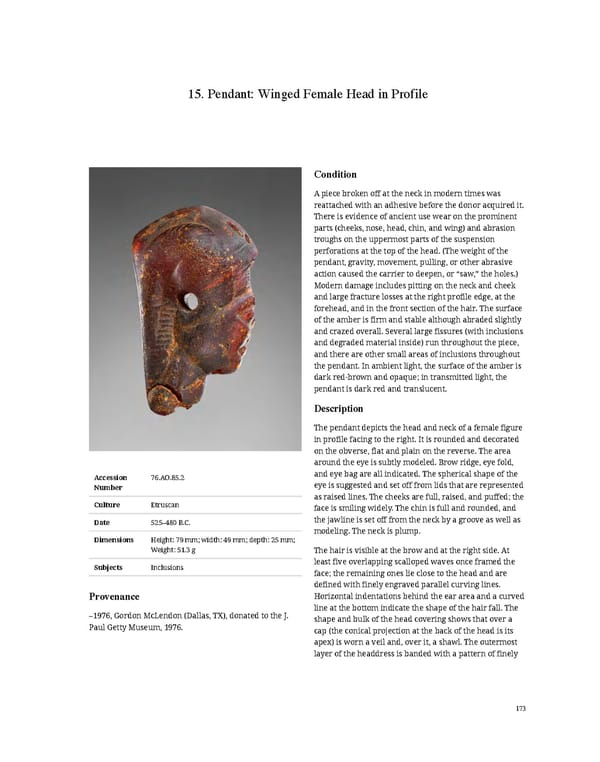15. Pendant: Winged Female Head in Profile Condition A piece broken off at the neck in modern times was reattached with an adhesive before the donor acquired it. There is evidence of ancient use wear on the prominent parts (cheeks, nose, head, chin, and wing) and abrasion troughs on the uppermost parts of the suspension perforations at the top of the head. (The weight of the pendant, gravity, movement, pulling, or other abrasive action caused the carrier to deepen, or “saw,” the holes.) Modern damage includes pitting on the neck and cheek and large fracture losses at the right profile edge, at the forehead, and in the front section of the hair. The surface of the amber is firm and stable although abraded slightly and crazed overall. Several large fissures (with inclusions and degraded material inside) run throughout the piece, and there are other small areas of inclusions throughout the pendant. In ambient light, the surface of the amber is dark red-brown and opaque; in transmitted light, the pendant is dark red and translucent. Description The pendant depicts the head and neck of a female figure in profile facing to the right. It is rounded and decorated on the obverse, flat and plain on the reverse. The area around the eye is subtly modeled. Brow ridge, eye fold, Accession 76.AO.85.2 and eye bag are all indicated. The spherical shape of the Number eye is suggested and set off from lids that are represented as raised lines. The cheeks are full, raised, and puffed; the Culture Etruscan face is smiling widely. The chin is full and rounded, and Date 525–480 B.C. the jawline is set off from the neck by a groove as well as modeling. The neck is plump. Dimensions Height: 79 mm; width: 49 mm; depth: 25 mm; Weight: 51.3 g The hair is visible at the brow and at the right side. At Subjects Inclusions least five overlapping scalloped waves once framed the face; the remaining ones lie close to the head and are defined with finely engraved parallel curving lines. Provenance Horizontal indentations behind the ear area and a curved line at the bottom indicate the shape of the hair fall. The –1976, Gordon McLendon (Dallas, TX), donated to the J. shape and bulk of the head covering shows that over a Paul Getty Museum, 1976. cap (the conical projection at the back of the head is its apex) is worn a veil and, over it, a shawl. The outermost layer of the headdress is banded with a pattern of finely 173
 Ancient Carved Ambers in the J. Paul Getty Museum Page 182 Page 184
Ancient Carved Ambers in the J. Paul Getty Museum Page 182 Page 184